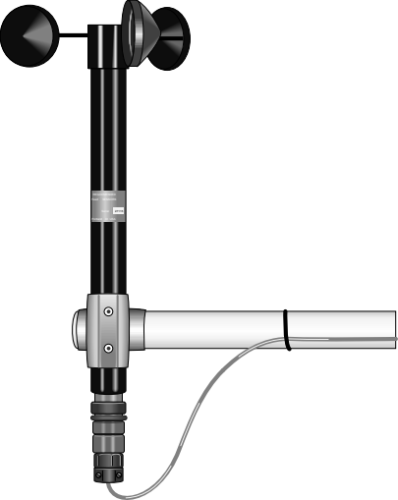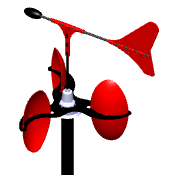The Function of an Anemometer in Improving Security for Outdoor Activities
The Function of an Anemometer in Improving Security for Outdoor Activities
Blog Article
Discovering the Functions and Advantages of Anemometers for Climate Fanatics and Experts
From cup anemometers to sonic anemometers, each type brings its special collection of applications and advantages, shedding light on various facets of atmospheric problems. As we delve right into the functions and advantages of anemometers, a much deeper understanding arises not only of prevailing climate sensations yet additionally of the wider ramifications for sectors like wind power production and ecological study.
Significance of Anemometers in Weather Condition Surveillance
Anemometers play an essential duty in weather tracking by giving accurate dimensions of wind rate, assisting in projecting and understanding weather patterns. These tools, ranging from conventional cup anemometers to modern-day ultrasonic anemometers, are necessary for meteorologists, scientists, and climate enthusiasts alike. By determining wind speed, anemometers help in determining the intensity of weather sensations such as cyclones, tornados, and twisters. In addition, they offer important data for aviation, maritime operations, and different markets that are sensitive to wind conditions.

Sorts Of Anemometers and Their Applications
The most typical types of anemometers consist of cup anemometers, vane anemometers, hot-wire anemometers, and ultrasonic anemometers. Mug anemometers are composed of three or four cups placed on horizontal arms that turn with the wind, determining its rate. Vane anemometers, on the various other hand, utilize an easily revolving vane to straighten with the wind instructions, giving both wind rate and instructions measurements.
Each type of anemometer has its distinct benefits and applications. Cup anemometers are robust and suitable for general climate tracking, while vane anemometers are preferred for directional dimensions. Hot-wire anemometers are delicate to low air velocities, making them perfect for indoor settings. Ultrasonic anemometers are non-intrusive and offer high accuracy, typically used in research and specialized climate surveillance applications. Recognizing the qualities and applications of each sort of anemometer is crucial for selecting one of the most ideal instrument for particular weather condition keeping track of needs.
Advantages of Making Use Of Anemometers in Projecting
In meteorology, the application of anemometers uses indispensable benefits for boosting the precision of climate projecting. Anemometers determine wind rate and instructions, supplying essential information for anticipating weather condition patterns. By incorporating wind information right into forecasting versions, meteorologists can much better comprehend the movement of weather condition systems, anticipate adjustments in weather, and problem a lot more accurate projections.
Moreover, anemometers play an essential function in assessing potential weather risks. Keeping track of wind rates helps forecasters predict severe weather occasions such as hurricanes, hurricanes, and winter tornados with greater accuracy. This very early caution system allows authorities to issue timely signals and apply required precaution, lowering the threats to life and home.
Furthermore, anemometers assist in maximizing sustainable power manufacturing. By examining wind patterns, meteorologists can recognize suitable places for wind ranches and forecast power output, adding to the efficient generation of wind power.

Anemometers in Wind Energy Production
Given the crucial role anemometers play in supplying precise wind information for weather condition projecting and risk assessment, their significance encompasses the world of wind energy manufacturing. Anemometers are important instruments in the area of wind power, where the measurement of wind speed and direction is vital for figuring out the expediency and performance of wind generator setups. By accurately determining wind rates at varying elevations, anemometers help enhance the placement and layout of wind generators to optimize power result.
In wind ranches, anemometers are purposefully put to collect real-time wind data that is made use of to examine the possible energy manufacturing of a site. This information contributes in determining the financial viability of wind power jobs and in projecting energy generation to make certain grid stability. Furthermore, anemometers help in keeping an eye on wind problems to maximize wind turbine performance, avoid damages from high winds, and ensure the safety of employees functioning in the area of wind generators.
Enhancing Weather Condition Understanding With Anemometers

Anemometers play a crucial role in improving our understanding of microclimates. These local weather can vary significantly from wider regional forecasts, making it vital to have precise data for details locations. anemometer. By purposefully putting anemometers in numerous places, scientists can collect comprehensive details on just how wind acts in different surfaces, urban environments, blog here or bodies of water
Moreover, anemometers add to boosting weather condition projecting models by offering real-time data on wind behavior. This details is specifically important for anticipating serious climate events, enhancing farming methods, and sustaining sectors like aviation and maritime navigation. Overall, anemometers are indispensable instruments that allow us to dive deeper into the complexities of climate systems, ultimately resulting in even more better-informed choices and precise forecasts.
Verdict
In conclusion, anemometers play a crucial role in weather condition tracking and projecting by gauging wind rate and direction. Anemometers also have applications in wind energy manufacturing, additional highlighting their value in both weather forecasting and eco-friendly energy industries.
From cup anemometers to sonic anemometers, each kind brings its distinct set of applications and benefits, shedding light on different facets of climatic conditions. These instruments, varying from traditional mug anemometers to contemporary ultrasonic anemometers, are important for meteorologists, scientists, and weather lovers alike. The most common types of Source anemometers include mug anemometers, vane anemometers, hot-wire anemometers, and ultrasonic anemometers. Cup anemometers are durable and ideal for basic weather condition surveillance, while vane anemometers are favored for directional measurements. Anemometers are crucial tools in the field of wind energy, where the measurement of wind speed and instructions is essential for determining the expediency and performance of wind turbine installments.
Report this page